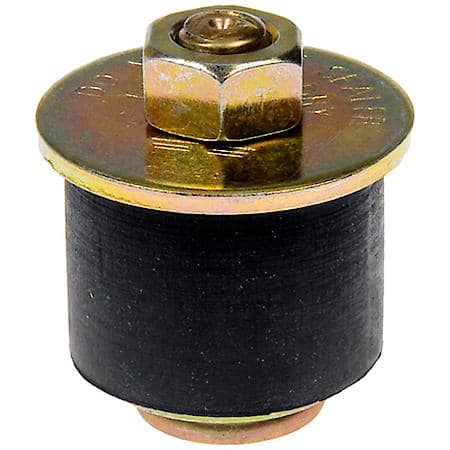-Is the countershaft lock nut 40mm or 32mm? Every parts site I look at for 90201-PR8-000 says it's a 32mm nut.
The countershaft nut is 40mm.
-Is there a flat on the countershaft to clamp with the vice to torque the new nut on? With the hollow shaft it seems iffy to clamp on the thinner parts.
There is no flat on the countershaft, you have to clamp the bottom gear that drives the ring gear in a vice between two blocks of wood. I'd recommend an impact gun to remove the nut.
-The factory SM says the torque sequence for the countershaft nut is 116->0->116 lb-ft, so it's meant to be torqued fully, taken off, then torqued again and staked? Didn't see that mentioned here.
I believe that's how it works.
-For your improvised "diff inspection tool", is it just some 10"+ all-thread that's double-nutted with washers on either side to clamp against the inner diff shaft inside of the tapered bearings? I assume the washers are doing the clamping since the diff splines aren't engaged to anything.
I used a long bolt I found at Home Depot. Something I thought of after the fact though, I would actually recommend you figure out some way to engage the splines instead though as theoretically the bolt could compress the differential housing enough to throw off the preload reading. If you use the bolt method, tighten it as little as possible, you only need to support like 30inlb.
-Reading through this and some other threads, I'm a bit unclear on the mainshaft thrust clearance procedure. This is what I gleaned for the procedure without the mainshaft holder tool:
1) Fully assemble mainshaft with both ball bearings, oil guide plate & original thrust shim(s) into housing (assuming it is the proper thickness, can be changed after first clearance measurement)
(OPTIONAL: leave thrust shim out, then subtract shim thickness from final clearance in last step to get a more accurate total clearance reading)
2) measure spring washer with micrometer, leave OUT of case
3) install mainshaft into housing, torque the case halves together
4) room temp, mainshaft oriented vertically, dial gauge on the mainshaft, zero, and pull shaft in & out to get a clearance reading (this clearance - spring washer thickness = 0.14-0.21mm according to FSM)
5) if (measured clearance - spring washer thickness) is NOT = 0.14-0.21mm, take mainshaft out again and upsize/downsize the thrust shim as needed
(i.e., if clearance without spring washer is 1.08mm, spring washer measures 0.82mm, final clearance is 0.26mm, so upsize thrust shim one size (+0.05mm) which would give ((1.08mm-0.05mm) clearance - 0.82mm spring = 0.21mm final clearance, on the upper edge of 0.14-0.21mm? Could go up another +0.05 thrust shim to land at 0.16mm)
Just looking for a sanity check of the above. I'm not planning on getting the mainshaft holder tool, and I read you can't measure the clearance with the spring washer installed without it since the washer needs to be compressed properly.
Thank you for asking this question, because I went back and read what I wrote, and it's little better than gibberish to me now that it's not all fresh in my mind, so not exactly a good explanation for someone who hasn't done it before, so I'll try to explain better.
The mainshaft shim selection procedure is two parts.
1) Select the appropriate shim thickness
What the service manual procedure does is measure the play in the mainsheet without the shim or spring washer, and use that to calculate allowable range of shim sizes. On page 13-41 you can see this process, and its rather crude. This process results in a value that you then subtract 0.99mm (0.0390") from to get the maximum shim thickness, and subtract 1.06mm (0.0417") to get the minimum shim thickness, then from this you can purchase the correct shim(s) to get you within that range.
The better way to find this measurement is to assemble the mainshaft, remove the thrust shim/spring washer/oil guide plate, then install the mainshaft and bolt the case halves together, and measure the the clearance with a dial indicator at the end of the mainshaft. You can then compute the desired shim thickness range using the values above and figure out what shim(s) you need to buy.
2) Confirm that the mainshaft has the correct clearance with the new shim
The second part of the process occurs after the correct shim thickness has been selected using the above method, and ensures that the mainshaft has the correct amount of movement with the spring washer installed. The service manual procedure uses a special mainshaft holder and a dial indicator to measure the travel of the mainshaft as the spring washer compresses, but we can approximate this measurement just by measuring the spring washer thickness.
When fully compressed, the spring washer is flat, so the thickness of the spring washer when fully compressed is the same as the thickness of the washer material when fully uncompressed (at least close enough for our purposes). To do this, install the mainshaft with the oil guide plate and shims, but WITHOUT the spring washer and bolt the case halves together, then measure the end play using a dial indicator. Finally, subtract the compressed thickness of the spring washer from this measurement, and you'll have your thrust clearance. The resulting value should be between 0.14mm (0.0055") and 0.21mm (0.0083"). If you measured everything correctly then you should hit it first try, if not, adjust the shim thickness and try again.
Last edited:





